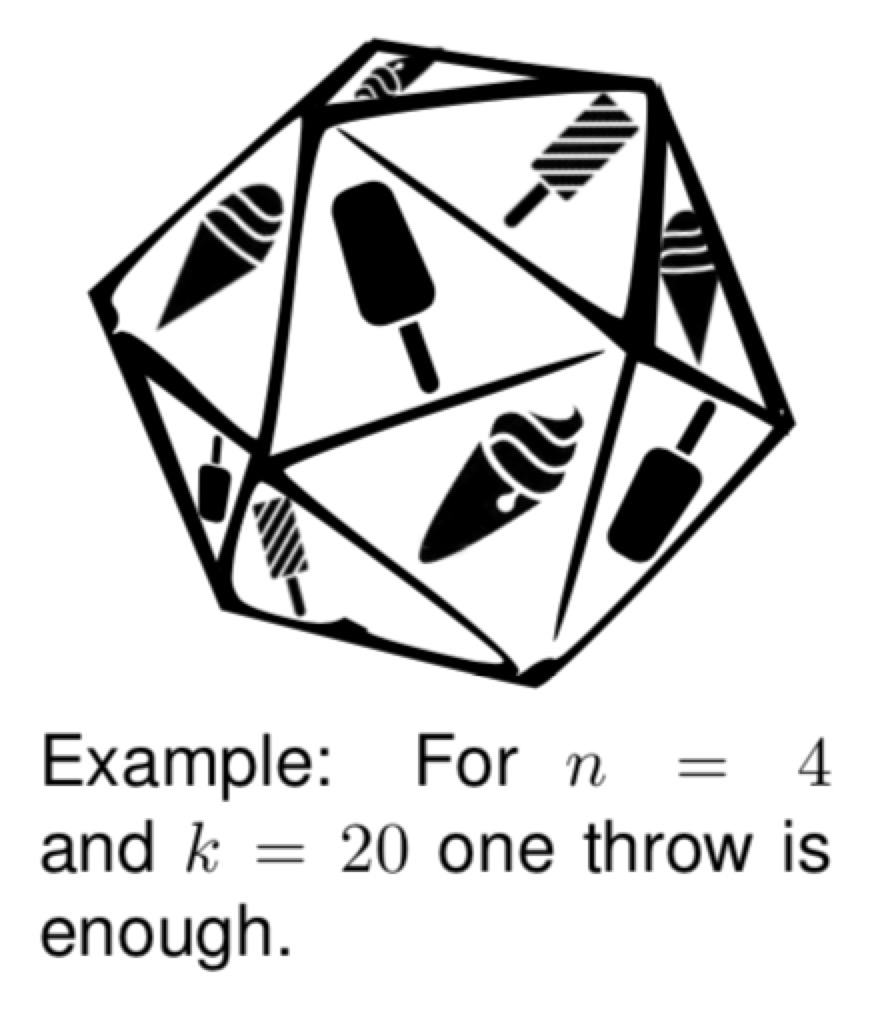You are standing in the supermarket in front of the freezers. You have a very tough task ahead of you: you have to choose what type of ice cream you want for after dinner that evening. After a while, you give up: they are all awesome! Instead, you take your (fair) kk-sided die out of your pocket and you decide to let fate decide.
Of course, the number of ice cream choices, nn, may not be precisely kk, in which case you could not just throw the die once, rolling ii, and take the iith ice cream choice. You therefore have to use some algorithm that involves zero or more die throws that results in an ice cream choice with every choice being exactly equally likely. Being a good computer scientist, you know about the accept-reject method, which would let you make such a fair choice.
At that point, you remember that you have a very importantcompetition to attend that same afternoon. You absolutely cannot afford to be late for that competition. Because of this, you decide you cannot use the accept-reject method, as there may be no bound on the number of die throws needed to ensure a fair result, so you may end up standing there for a long time and miss the competition! Instead, you resolve to find an algorithm that is fair and uses as few dice choices as possible in the worst case.
Given nn and kk, can you determine the minimum number ii such that there is a fair algorithm that uses at most iidie throws per execution?
Input Format
On the first line one positive number: the number of test cases, at most 100. After that per test case:
- one line with two space-separated integers nn and kk (1 \leq n, k \leq 10^91≤n,k≤109): the number of ice cream choices and the number of sides of your die, respectively.
Output Format
Per test case:
- one line with a single integer: the smallest number of throws after which you are guaranteed to be able to make a fair choice. If there is no such number, print “unbounded” instead.
样例输入
3 4 2 2 4 3 2
样例输出
2 1 unbounded
题目来源
计蒜客上面的一道题,然后题目意思不太好懂。
题目意思是:有n个冰淇淋要吃,你有个骰子,k个面,问你投几次能够公平的决定出吃哪个冰淇淋,公平就是指的概率相等。
然后对于样例的 4 2 ,4个冰淇淋,骰子2面, 骰子两面记为 1,2 。那么投两次出现的情况组合分别是 1,1;1,2;2,1;2,2;
分别对应四个冰淇淋,所以投两次就可以了。
所以对于投骰子,找出组合情况数,能够整除n就行了。
简单点来说就是 k的幂次方能够整除n就行了。
但是写起来就没有这么好写了。
因为k的幂次方有可能会超过long long
因此就要用到唯一分解定律,判断他们的因子。
如果知识遗漏的,可以看一下这篇博客
https://blog.csdn.net/m0_38081836/article/details/78108166
#include<iostream>
#include<cstdio>
#include<cstring>
#include<algorithm>
#include<vector>
#include<stack>
#include<cmath>
#include<queue>
#include<map>
#define inf 0x3f3f3f3f
using namespace std;
typedef long long ll;
int n,k;
vector<int> v1,v2;
map<int,int> m1,m2;
bool judge( int x )
{
int r = (int)sqrt( (double)x );
for( int i = 2 ; i <= r ; i++ )
if( x % i == 0 )
return false;
return true;
}
int main()
{
int T;
scanf("%d",&T);
while( T-- )
{
v1.clear();
v2.clear();
m1.clear();
m2.clear();
scanf("%d %d",&n,&k);
if( n == 1 )
{
printf("0\n");
continue;
}
if( judge(n) == false )
{
for( int i = 2 ; i <= n ; i++ )
{
while( n%i == 0 )
{
if( m1[i] == 0 )
v1.push_back(i); //储存因子
m1[i]++;
n = n/i;
}
}
}
else //如果是质数,只有本身一个因子
{
v1.push_back(n);
m1[n]++;
}
if( judge(k) == false )
{
for( int i = 2 ; i <= k ; i++ )
while( k%i == 0 )
{
if( m2[i]%i == 0 )
v2.push_back(i);
m2[i]++;
k = k/i;
}
}
else
{
v2.push_back(k);
m2[k]++;
}
bool flag = true;
int ans = 0,temp;
for( int i = 0 ; i < v1.size(); i++ )
{
temp = 0;
int t = v1[i];
if( m2[t] == 0 )
{ //n的因子在k中没有,那么一定unbounded
flag = false;
break;
}
if( m1[t] <= m2[t] ) //如果k的单个因子个数大于n,则只需要一个k就行了,即目前只用投1次
{
temp = 1;
}
else
{
temp = m1[t]/m2[t]; // n的单个因子个数大于k,则需要除一下,不能整除要+1
if( m1[t]%m2[t] != 0 )
temp++;
}
ans = max(temp,ans);
}
if( flag )
printf("%d\n",ans);
else puts("unbounded");
}
return 0;
}
/*
16 6
16 8
16 24
*/
